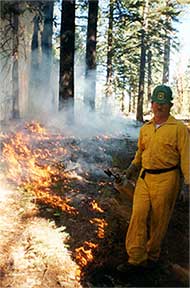 Many North American forests, especially those with historically short-interval, low- to-moderate severity fire regimes, are extremely dense with excessive quantities of fuels. Widespread treatments are needed to restore ecological integrity and reduce wildfire hazard in these forests. Among possible restorative treatments the appropriate balance among silvicultural treatments, mechanical fuel treatments, and prescribed fire is often unclear. The focus of the Fire and Fire Surrogate Study is to provide quantitative information on the use of the following silvicultural treatments: (1) harvesting and mechanical fuel treatments in the absence of fire, (2) fire alone, with no harvesting or mechanical treatment, (3) a combination of harvesting, mechanical fuel treatments, and prescribed fire, and (4) a control, with no treatments. The treatment effects will be examined through broad ecological disciplines including: fire and fuels, vegetation, wildlife, entomology, pathology, soils, and utilization/economics. These treatments are being implemented at 10 other sites across the United States. At Blodgett, each of the 4 treatments will be carried out on three 40-60 acre group selection compartments. Many North American forests, especially those with historically short-interval, low- to-moderate severity fire regimes, are extremely dense with excessive quantities of fuels. Widespread treatments are needed to restore ecological integrity and reduce wildfire hazard in these forests. Among possible restorative treatments the appropriate balance among silvicultural treatments, mechanical fuel treatments, and prescribed fire is often unclear. The focus of the Fire and Fire Surrogate Study is to provide quantitative information on the use of the following silvicultural treatments: (1) harvesting and mechanical fuel treatments in the absence of fire, (2) fire alone, with no harvesting or mechanical treatment, (3) a combination of harvesting, mechanical fuel treatments, and prescribed fire, and (4) a control, with no treatments. The treatment effects will be examined through broad ecological disciplines including: fire and fuels, vegetation, wildlife, entomology, pathology, soils, and utilization/economics. These treatments are being implemented at 10 other sites across the United States. At Blodgett, each of the 4 treatments will be carried out on three 40-60 acre group selection compartments.
A core interdisciplinary team of scientists including University of California professors, postdoctoral students, and Extension specialists is developing sampling protocols. Immediate field activities include plot layout, tree marking, and testing small scale prescribed burns. Field measurements will begin at Blodgett in spring of 2001. Harvesting of the mechanical treatment units will begin in August 2001. Prescribed burning will be carried out in the fall of 2002. Successive measurements will occur in the summer of 2003 and 2004. Data will be analyzed locally and across all national sites. Funding for this project has been obtained through the U.S. Joint Fire Science Program in Washington D.C.
 FIRE SURROGATE STUDY: FIRE SURROGATE STUDY:
Blodgett Forest is part of a national network of research sites designated for study to quantify the consequences and tradeoffs of alternative fire and fire surrogate treatments, including ecological, economic and social aspects. Research is aimed at cause and effect relationships. Prescribed burns are one of four fire surrogate treatments that will be implemented at each research site.
|
Photos by Jason Moghaddas and Emily Greinke
|
|
 |
 |
|
Contact Author: Scott L. Stephens, Department of Environmental Science, Policy and Management, University of California, Berkeley, 145 Mulford Hall #3114, Berkeley, CA 94720-3114, (510) 642-7304, stephens@nature.berkeley.edu
Jason Moghaddas, Site Manager for the Fire and Fire Surrogate Study, moghad@nature.berkeley.edu
|

 Many North American forests, especially those with historically short-interval, low- to-moderate severity fire regimes, are extremely dense with excessive quantities of fuels. Widespread treatments are needed to restore ecological integrity and reduce wildfire hazard in these forests. Among possible restorative treatments the appropriate balance among silvicultural treatments, mechanical fuel treatments, and prescribed fire is often unclear. The focus of the Fire and Fire Surrogate Study is to provide quantitative information on the use of the following silvicultural treatments: (1) harvesting and mechanical fuel treatments in the absence of fire, (2) fire alone, with no harvesting or mechanical treatment, (3) a combination of harvesting, mechanical fuel treatments, and prescribed fire, and (4) a control, with no treatments. The treatment effects will be examined through broad ecological disciplines including: fire and fuels, vegetation, wildlife, entomology, pathology, soils, and utilization/economics. These treatments are being implemented at 10 other sites across the United States. At Blodgett, each of the 4 treatments will be carried out on three 40-60 acre group selection compartments.
Many North American forests, especially those with historically short-interval, low- to-moderate severity fire regimes, are extremely dense with excessive quantities of fuels. Widespread treatments are needed to restore ecological integrity and reduce wildfire hazard in these forests. Among possible restorative treatments the appropriate balance among silvicultural treatments, mechanical fuel treatments, and prescribed fire is often unclear. The focus of the Fire and Fire Surrogate Study is to provide quantitative information on the use of the following silvicultural treatments: (1) harvesting and mechanical fuel treatments in the absence of fire, (2) fire alone, with no harvesting or mechanical treatment, (3) a combination of harvesting, mechanical fuel treatments, and prescribed fire, and (4) a control, with no treatments. The treatment effects will be examined through broad ecological disciplines including: fire and fuels, vegetation, wildlife, entomology, pathology, soils, and utilization/economics. These treatments are being implemented at 10 other sites across the United States. At Blodgett, each of the 4 treatments will be carried out on three 40-60 acre group selection compartments.
 FIRE SURROGATE STUDY:
FIRE SURROGATE STUDY:
